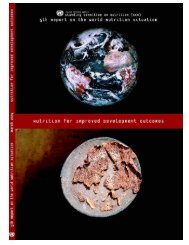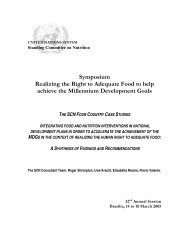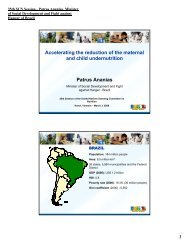Universal Salt Iodization (USI) - FTP Directory Listing
Universal Salt Iodization (USI) - FTP Directory Listing
Universal Salt Iodization (USI) - FTP Directory Listing
- No tags were found...
Create successful ePaper yourself
Turn your PDF publications into a flip-book with our unique Google optimized e-Paper software.
46FEATURESFigure 2: IDD/<strong>USI</strong> Taskforce Partnership in Nigeriawww.unsystem.org/scnNigeria <strong>USI</strong> Program OverviewIDD Program Coordination, Activities & Implementing AgenciesCoordinating Focal Point: FMOHIECDatabaseNutrition SurveillanceIDD-<strong>USI</strong> TASK FORCE: SONFMOHFMEIECINDUSTRYNAFDACSONFood ControlNAFDACFMEFMOHNationalMNMEventsConsumerHealthEducationBrandedCampaign&SchoolsGenericCampaign& GovtAdvocacyPortFactoryInspectionDistributorRetailInspectionSchoolHouseholdSurveysSentinelSites.Labs.This partnership has enabled all stakeholders to monitor trends in compliance at factory, wholesale, retail andhousehold levels and intervene where necessary.ResultsResults in terms of coverage of iodization:• <strong>Iodization</strong> at factory level: Since 1995, records of inspection at ports of entry and at salt factoriesconsistently indicate 90 100% of consignments with iodine levels above 50ppm.• <strong>Iodization</strong> at wholesale and retail levels: Results of wholesale and retail level surveys for 2002, 2003 and2005 indicate that 97-100% of salt meet the standard of more than 30ppm iodine content. Since 2002,approximately 20,000 salt samples have been analyzed.• Access to iodized salt at household level: Results consistently indicate that access to adequately iodizedsalt at the household level is over 98%.• Median urinary iodine excretion levels: Biochemical assessments of urinary iodine mirrors the dramaticallylower TGR recorded during the 1990s. A study published in Public Health Nutrition in 1998 reported meanlevels of urinary iodine content of 146.5 μg/dl with a median of 133.9 μg/dl. In 2002, the study of the 16endemic states by Egbuta et al reported urinary iodine content of 90-156 μg/dl. These results werereaffirmed by the Nigeria Food Consumption and Nutrition Survey (NFCNS) undertaken by theInternational Institute of Tropical Agriculture (IITA) in 2001, which found median urinary iodine levels inchildren under 5 years of age to range from 119 to 309 μg/dl. The UNICEF 2005 National TGR andUrinary Iodine Survey recorded a value of 131 μg/dl urinary iodine level.• Total goitre rate: Studies confirm the impact of Nigeria’s <strong>USI</strong> law on goitre prevalence: In 30 states, peopleaffected dropped from 40 million in 1990 to less than 11 million in 1999 (ICCIDD 2000). The Nigeria‘Damage Assessment Report’ (UNICEF/MI 2004) estimated a lower TGR of 7.7%. A national survey in2005 put the national TGR at 6.2% (UNICEF 2005).Having achieved sustained 98% of households’ access to adequately iodized salt since 1998, a goitreprevalence rate of about 6%, and a median urinary iodine excretion of more than 130 μg/dl since 1999,Nigeria was certified as <strong>USI</strong> compliant in 2005 by the Network for Sustained Elimination of Iodine Deficiency.This made Nigeria the first country in Africa to achieve this feat. Nigeria currently ranks 6 th on the globaliodized salt consumption out of the 200 countries assessed and reported on the 2006 Global Score Card.Furthermore, the 10 point criteria for <strong>USI</strong> certification had been met, namely evidence of politicalcommitment, a functional national multi-disciplinary body on IDD/<strong>USI</strong>, a national executive officer for IDDelimination, legislation and regulation on <strong>USI</strong>, commitment to assessment and re-assessment of progress,SCN NEWS # 35 back to contents







